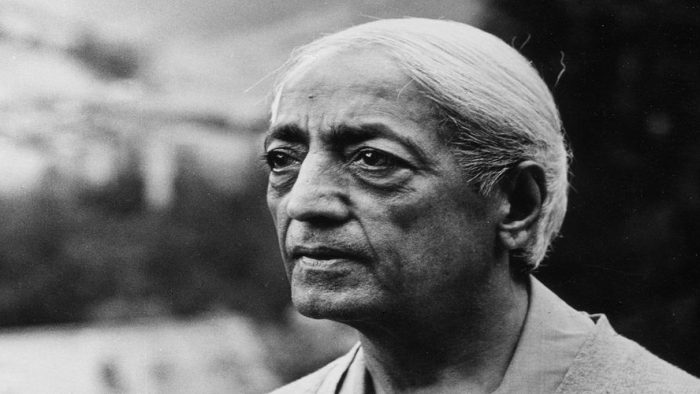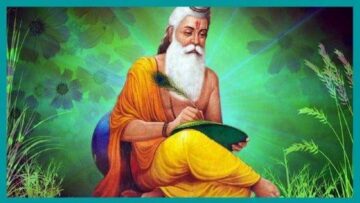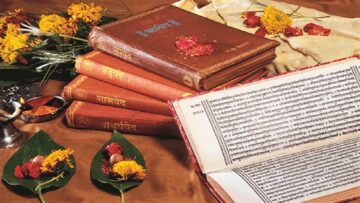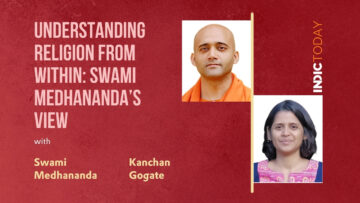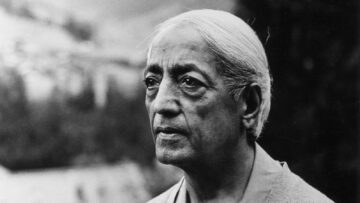A renowned thinker and philosopher J Krishnamurti’s concept of mindfulness which he called Choiceless Awareness is considered an essential contribution to psychology, spirituality, and philosophy though he repudiated connections organised religions, philosophies and scriptures. At the same time, Ashtavakra Gita or Samhita, is known as a classical Advaita text where Ashtavakra focuses on the vision of self as the absolute witness (Sakshi). By Choiceless Awareness, J Krishnamurti meant an action with awareness which is not the result of choice. Krishnamurti has been conceptually compared with the ideas in Buddhism, Zen and Advaita Vedanta. Drawing parallels between Choiceless Awareness and Sakshi Bhav, this paper tries to examine how these can be the ultimate approaches to mindfulness.
Choiceless Awareness: Core of Krishnamurti’s teachings
J Krishnamurti was a 20th century mystic, philosopher and thinker. He was prepared to be the World Teacher by the Theosophical Society. However with his landmark speech ‘Truth is a pathless Land’ in 1929, he denied being the World Teacher. Hereafter, he lectured extensively across the world. Without taking the basis of organised religion, philosophies and scriptures, he primarily focussed on awareness without conditioning.
All of Krishnamurti’s teachings can be summed up in ‘awareness’. He spoke about passive and Choiceless awareness which is ‘observing’ ‘what is’.
Awareness is the silent and Choiceless observation of what is; in this awareness, the problem unrolls itself, and thus it is fully and completely understood.
By awareness, Krishnamurti meant purely being in a moment or observing without evaluating. According to him, our fears, anxieties, thoughts, pleasures and constant efforts of bettering comprise the content of human consciousness. Thus, our seeing or listening, or any action primarily comes from the content of consciousness and awareness can come only when we vacate the consciousness with its content.
To be factually and choiceless aware of all that is in yourself, to observe it without effort- it is in the state of effortless awareness that there is a total revolution.
Or
You have to see yourself as you are from moment to moment without interpreting what you see and without accumulating knowledge about yourself; you have to observe with Choiceless awareness.
This Choiceless Awareness is something which Krishnamurti said can ‘end the sorrow’ or determine our ‘approach to the problem.’
The approach to the problem is more important than the problem itself; the approach shapes the problem, the end. Choiceless awareness of the manner of your approach will bring the right relationship with the problem.
When Krishnamurti’s official biographer Mary Lutyens approached him for the gist of his writing, he wrote ‘Core of the Teachings’ where he said,
Freedom is not a reaction; freedom is not a choice. It is man’s pretence that because he has a choice he is free. Freedom is pure observation without direction, without fear of punishment and reward…Freedom is found in the Choiceless Awareness of our daily existence.
Witnessing the absolute: Ashtavakta Gita.
Ashtavakra Gita is known as the classical and the ultimate scripture on Advaita Vedanta. It is a dialogue between King Janaka and Ashtavakra. Though the exact times and details of Ashtavakra’s life are unknown, there are some stories about Ashtavakra, the sage. However, he is known for his revolutionary message because the emphasis is not on following rituals or scriptures or knowledge but stress is on being aware of the pure self. It was the text which Sri Ramakrishna often referred to Swami Vivekananda. Many masters in Vedantic tradition rather caution sadhaks about reading this as it is considered to be only for ‘advanced spiritual practitioners’. Ashtavakra Gita or Samhita is all about realizing the nature of the self as the absolute witness. The first chapter itself is titled as the Sakshi, as the all-pervading witness.
In the very first chapter, Ashtavakra says:
न पृथ्वी न जलं नाग्निर्न वायुर्द्यौर्न वा भवान् ।
एषां साक्षिणमात्मानं चिद्रूपं विद्धि मुक्तये ॥ १-३॥
If you wish to be free,
Know you are the Self,
The witness of all these,
The heart of awareness.
Ashtavakra says that you are already pure and there is nothing to be renounced. You are pure.
न ते संगोऽस्ति केनापि किं शुद्धस्त्यक्तुमिच्छसि ।
संघातविलयं कुर्वन्नेवमेव लयं व्रज ॥ ५-१॥
Nothing touches you
What is there to renounce?
Let it all go,
The body and the mind.
Let yourself dissolve.
Thus Ashtavakra talks about mindfulness as a witness, an observer and knower of own pure self and not as a practice. Krishnamurti also talks about it as Choiceless Awareness as action without choice, with just understanding of what is. While Krishnamurti’s teachings are already compared to Zen, Tao, Buddhism and Advaita Vedanta, he can also be called Modern Ashtavakra.
Krishnamurti’s Choiceless Awareness and Ashtavakra’s Witness: Comparative Analysis
As Krishnamurti often refrained from making Gurus, religions and scriptures as reference points, any comparison any based on a tradition or a pattern may not be appropriate. However, this paper conducts the conceptual analysis of the ideas explored by Krishnamurti and Ashtavakra with special reference to Choiceless Awareness and Witness, Sakshi Bhav in order to understand them as the ultimate approaches to mindfulness. Thomas Byrom, in his translation of Ashtavakra Gita titled Heart of Awareness, says, ‘Our true nature is pure and Choiceless Awareness. We are all ready and always fulfilled. It is easy, says Ashtavakra’. While Krishnamurti’s philosophy is available through a large body of literature, Ashtavakra’s message is condensed in a small book in 20 chapters.
- Know thyself as the absolute true nature
Krishnamurti said choice implied conflict, effort. Being Choiceless is all about being aware of the things as they are. Thus, knowing or seeing as it is the mindfulness which Krishnamurti said, “This is why it is very important to know oneself, not according to any formula or according to any guru. This constant choiceless awareness ends all illusions and all hypocrisy. “
Ashtavakra says that no efforts are needed to be. Know that you are the ultimate, Choiceless and unchanging, awareness itself.
रागद्वेषौ मनोधर्मौ न मनस्ते कदाचन ।
निर्विकल्पोऽसि बोधात्मा निर्विकारः सुखं चर ॥ १५-५॥
Desire and aversion are of the mind. 5
The mind is never yours.
You are free of its turmoil.
You are awareness itself,
Never changing.
Wherever you go. Be happy.
Swami Shantananda Puri, in his commentary on Ashtavakra Gita, which he has called the Quantum Leap, says Ashtavakra’s sakshi bhav approach reminds him of Jiddu Krishnamurti’s Choiceless Approach. ‘The Choiceless perception of all events and happenings from the Witness state, unprejudiced, uninvolved and bereft of any judgement or categorisation (as good or bad, pleasant or unpleasant) and Ashtavakra’s exhortation about the futility of utter dependence on the preceptor (Guru) reminds one of the teachings of J. Krishnamurthy(sic), an eminent philosopher of recent times.’
2. Observer is the observed
Krishnamurti dealt with the absolute non-duel ideas. When one is seeing, listening or observing, is that one is different from what is being observed? Krishnamurti said that observer and the observed often bring division and that brings conflict. ‘When one sees the observer is the observed, therefore, you eliminate all conflict.’ Thus, Krishnamurti said that it was the ending of all dualities when there are no divisions.
Observer is the observed is one of the terms that Krishnamurti used along with the Thinker and the Thought, Experiencer and the Experienced, Meditation and the Meditator. When this duality ends, there remains true awareness. He said that and observations stem from the thinker and observer.
The observer and the observed are one, thinker and the thought are one. To experience this actual integrated fact is extremely difficult and the right meditation is the way to this integration.
Ashtavakra says that know yourself as a witness, sakshi and an objective observer.
आत्मा साक्षी विभुः पूर्ण एको मुक्तश्चिदक्रियः ।
असंगो निःस्पृहः शान्तो भ्रमात्संसारवानिव ॥1.12II
The self is the witness, all-pervading, perfect, the one free consciousness, actionless, unattached and desireless and quiet. Through the illusions, it appears of this world (bound to the world, cycles of birth and death).
- Meditation not an action but a continuous mindfulness
Krishnamurti discouraged everything that was methodical, ritualistic and a pattern. Therefore, he never looked at awareness and meditation as methods or processes. He rather said ‘never ask how as how implies a method’. He didn’t define meditation as a concentration or a thoughtless process. He was rather for the effortless meditation that happens than something that is brought about.
Meditation is not a means to an end. It is both the means and the end. Meditation is the ending of thought, not by the meditator, for the meditator is the meditation. If there is no meditation, then you are like a blind man in a world of great beauty, light and colour.
To awaken the self-awareness, Ashtavakra says that meditation should be on one’s pure nature.
कूटस्थं बोधमद्वैतमात्मानं परिभावय ।
आभासोऽहं भ्रमं मुक्त्वा भावं बाह्यमथान्तरम् ॥ १-१३॥
Meditate on this: “I am Awareness, a witness of all things alone–Unity itself.”
Give up the idea that you are separate, a person, that there is within and without.
Krishnamurti also said that the right meditation was when all dualities of observer and the observed came to an end. To him, meditation is the greatest art in life. ‘It cannot be learnt from anybody and it is the beauty of it.’ Therefore, to Krishnamurti, meditation and awareness were not conscious and deliberate activities. He called meditation as ‘the emptying the content of consciousness’. Effortlessness is the key to Krishnamurti’s meditation as he says, “All effort to meditate is the denial of meditation.”
Ashtavakra says you are bound only by the habit of meditation.
निःसंगो निष्क्रियोऽसि त्वं स्वप्रकाशो निरंजनः ।
अयमेव हि ते बन्धः समाधिमनुतिष्ठति ॥ १-१५
And be happy!
For you are already free, 15
Without action or flaw,
Luminous and bright.
You are bound
Only by the habit of meditation.
- Witness to the Choicelessness
Krishnamurti says true and objective observation takes place only when there is no choice. Exercising choice is duality while Choicelessness is the ultimate non-dual. Thus, Krishnamurti has called Choicelessness as a state which Ashtavakra has called a witness, a Sakshi.
To be aware of the past in that choiceless observation is not only to act differently but to be different. …To be religious is to be so choicelessly aware that there is freedom from the known even whilst the known acts wherever it has to.
Krishnamurti also said that it is the truth of understanding true self that liberates and your desire for liberation.
Ashtavakra says that even desire for liberation must drop.
बुभुक्षुरिह संसारे मुमुक्षुरपि दृश्यते ।
भोगमोक्षनिराकांक्षी विरलो हि महाशयः ॥ १७-५॥
Those who desire pleasure
and those who desire liberation
are both common in the world.
Rare is the great soul who desires neither enjoyment nor liberation.
Ashtavakra is truly for witnessing the things as they are and not making choices as choice implies at duality. When one is a true witness of Choicelessness, no renunciation is needed, says Ashtavakra.
हातुमिच्छति संसारं रागी दुःखजिहासया ।
वीतरागो हि निर्दुःखस्तस्मिन्नपि न खिद्यति ॥ १६-९॥
If you desire the world, 9
You may try to renounce it
In order to escape sorrow.
Instead, renounce desire!
Then you will be free of sorrow
And the world will not trouble you
You are Choiceless, awareness itself and unchanging – so live happily, says Ashtavakra
तात चिन्मात्ररूपोऽसि न ते भिन्नमिदं जगत् ।
अतः कस्य कथं कुत्र हेयोपादेयकल्पना ॥ १५-१२॥
You are the pure intelligence itself. The universe is no different from you, it’s just an idea. How can you (make a choice) accept or reject when you’re the infinite self everywhere.
Choicelessness is the ultimate state where nothing remains. That has been called empty, the absolute or Sakshi by Ashtavakra. Prof Allan W Anderson, religious philosophy scholar, describes the state as, ‘Choicelessness is the mind’s equivalent of the silence out of which intelligible utterance arises, of “that emptiness in which the things of the mind can exist but the things are not the mind … that emptiness has no centre and so is capable of infinite movement.’
Ashtavakra has said that be, what you are already Choiceless and don’t try to become. Quantum leap is about jumping directly and not gradually, that’s what Ashtavakra is about. ‘We have to behave in actual life as the liberated self, free, unconcerned and uninvolved, Choiceless and Desireless’
- Witnessing ‘what is’: the ultimate Mindfulness
While Krishnamurti called awareness is observation without conditioning. Memories, thoughts, anxieties and all emotions often interfere with the act of pure observation. Sakshi bhav, or a witness has been emphasised in Vedic literature as the act of pure observation. Those concepts are almost parallel.
Awareness is an observation, both outer and inner, in which direction has stopped. You are aware, but the thing of which you are aware is not being encouraged or nourished. Awareness is not concentration on something. It is not an action of the will choosing what it will be aware of, and analysing it to bring about a certain result.
Ashtavakra’s message is giving up the doer-ship and not an action. He says don’t look at self as the doer, seeker, enjoyer or someone who is involved in action. Sakshi is the one who can see even one’s own actions not as an actor but with Sakshi bhav, as a witness
न त्वं देहो न ते देहो भोक्ता कर्ता न वा भवान् ।
चिद्रूपोऽसि सदा साक्षी निरपेक्षः सुखं चर ॥ १५-४॥
You are not the body, this body is not yours. You are not the doer nor the enjoyer. You are consciousness itself, eternal witness and free. Go about it happily.
One of the translators of Ashtavakra Gita Bart Marshall has called Sakshi as a ‘solitary witness’. Sakshi is someone who is not affected by this world or its afflictions says Vedic wisdom. Approaches of Ashtavakra and Krishnamurti are similar though they belong to different times or have used different terminologies.
Krishnamurti talked of awareness that comes without any authorities, gurus, methodologies and even scriptures. He emphasized on the understanding of ourselves without any help, external authority.
The guru becomes useless when there is a particle of self-knowledge. No guru, no book or scripture, can give you self-knowledge: it comes when you are aware of yourself in a relationship.
He also said that, “An ignorant man is not unlearned, but he who doesn’t know himself, and the learned man is stupid when he relies on books, on knowledge, on authorities to give him understanding.”
Ashtavakra also says unless there is looking inward and forgetting of all scriptures, there is no self-knowledge.
आचक्ष्व शृणु वा तात नानाशास्त्राण्यनेकशः ।
तथापि न तव स्वास्थ्यं सर्वविस्मरणाद् ऋते ॥ १६-१॥
My child,
You may read or discuss scripture
As much as you like.
But until you forget everything,
You cannot come to truth.
Ashtavakra is for being witness to the absolute self that you are already, without seeking liberation. To him, the mindfulness is about being aware of your liberated nature.
विज्ञाते साक्षिपुरुषे परमात्मनि चेश्वरे ।
नैराश्ये बंधमोक्षे च न चिंता मुक्तये मम ॥ १४-३॥
Liberation,
Bondage,
What are they to me?
What do I care for freedom?
For I have known God,
The infinite Self,
The witness of all things.
Prof P Krishna, one of the exponents of Krishnamurti’s teachings said that when someone asked Krishnamurti about understanding teachings, he promptly replied, “Sir, there is no such thing as my teachings. You don’t have to understand the teachings, you have to understand yourself.”
- Witness and Choicelessness: Quantum leaps in mindfulness
In spite of the difference of time, language and outlooks, this paper argues that the approach of Krishnamurti and Ashtavakra are the ultimate approaches to mindfulness though neither of them used the word. Both stressed upon the pure observation for the self-knowledge, which is awareness. Thus, Sakshi Bhav and Choiceless awareness are not methodologies, but alertness of pure being all the time.
One of the biggest similarities in their approaches is that they do not give time. Both of them are keen on the awareness and the mindfulness that is instantaneous. The approach is similar in Buddhism and Zen where mindfulness is a means and an end itself. Samdhong Rinpoche, a renowned Tibetan Buddhist Scholar said Krishnamurti took the last step as he observes, ‘Krishnamurti observed carefully, minutely and in great detail, the present state of human conditioning…all sources of liberation we have made into the cause of bondage….therefore on Krishnamurti’s insight, there is only one step. Otherwise, all steps are the same leading nowhere.”
Similarly, Swami Shantananda observes that ‘Ashtavakra claims that enlightenment can be instantaneous (अधुनैव). This is the quantum flight from body consciousness to the eternal Existence. There are no processes, stages, auxiliary means or anything else involved. One should be careful not to meditate or think as “I AM’ but to simply remain in that fact of one’s Existence.”
As awareness of self as the real cannot be expressed in words, both of them employed ‘negative approach’, which is Neti Neti, not this, not this in Advaitic wisdom. As Rinpoche puts it, ‘The Buddha and Krishnamurti, both employed the method of negation, because as the reality perceived by them is incommunicable through language…the only way left for them is to negate all possible conceptions of thought or imagination..’
Witness, the Sakshi Bhav and Choiceless awareness are the ultimate non-dualities.
Finally negating everything, what remains is the pure awareness, who knows, what Ashtavakra says,
क्व चास्ति क्व च वा नास्ति क्वास्ति चैकं क्व च द्वयम् ।
बहुनात्र किमुक्तेन किंचिन्नोत्तिष्ठते मम ॥ २०-१४॥
Nothing is,
Nothing is not.
What more is there to say?
Mindfulness Explained: Postscript
While Krishnamurti coined many terms to express mindfulness or Choiceless Awareness, Ashtavakra used plenty of Sanskrit adjectives to explain the witness. Krishnamurti gives elaborate descriptions which are immaculately clinical, Ashtavakra is precise and unambiguous. A cursory look the terminologies both used to explain that awareness, mindfulness, alertness or witness can help us understand more similarities in their approaches.
Ashtavakra’s terms for Sakshi bhav
शुद्धबुद्धस्वरूपस्त्वं (Pure consciousness by nature)
शुद्धबोधस्य: (Pure consciousness)
अंतर्विकल्पशून्य (Emptiness from within)
सत्त्वबुद्धिमान् (A man of pure intellect)
चिन्मात्ररूपिणः (Desiring for consciousness alone)
शून्यचित्तो (Empty minded, void)
कैवल्यमिव (The state of absoluteness)
भावाभावविभाविनाम् (Inherent inexistent and non-existent)
निर्विकल्पं (Free from conflict)
तस्यालस्य धुरीणस्य (Master ‘idler’, whose non-action is out of realization and not laziness)
शुद्धरूपिणा (Of pure nature)
शुद्धबुद्धिर्निराकुलः (Who has attained pure knowledge and is calm and wise)
शून्याकारा निराकारा निर्विकारा निरामयाः (Form of a void, formless, immutable, untainted)
पूर्णस्वरसविग्रहः (Perfect embodiment of bliss which is one’s own nature)
भोगमोक्षनिराकाङ्क्षी (One beyond bhoga and liberation)
शुद्धबोधस्य (The one who is pure consciousness)
शुद्धस्फुरणरूपस्य (Nature of self-effulgent)
निःस्वभावस्य (Impersonal)
Krishnamurti’s terminologies for awareness (many of which are his book titles)
Choiceless and passive awareness
Observer is the observed
Freedom from the Known
Awakening of intelligence
You are the world
Benediction is where you are
Truth is a pathless land
Future is now
Disclaimer: The opinions expressed in this article belong to the author. Indic Today is neither responsible nor liable for the accuracy, completeness, suitability, or validity of any information in the article.

